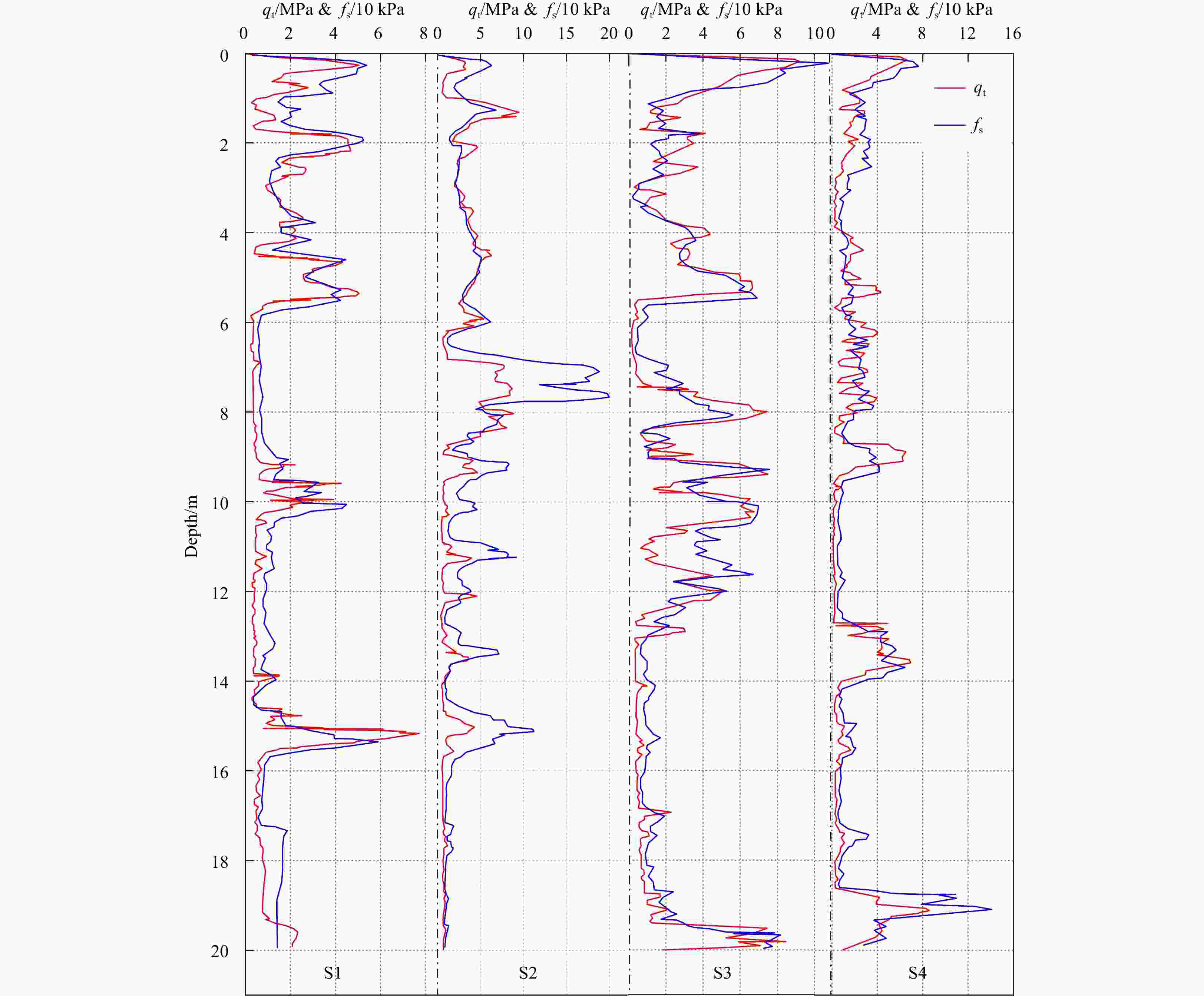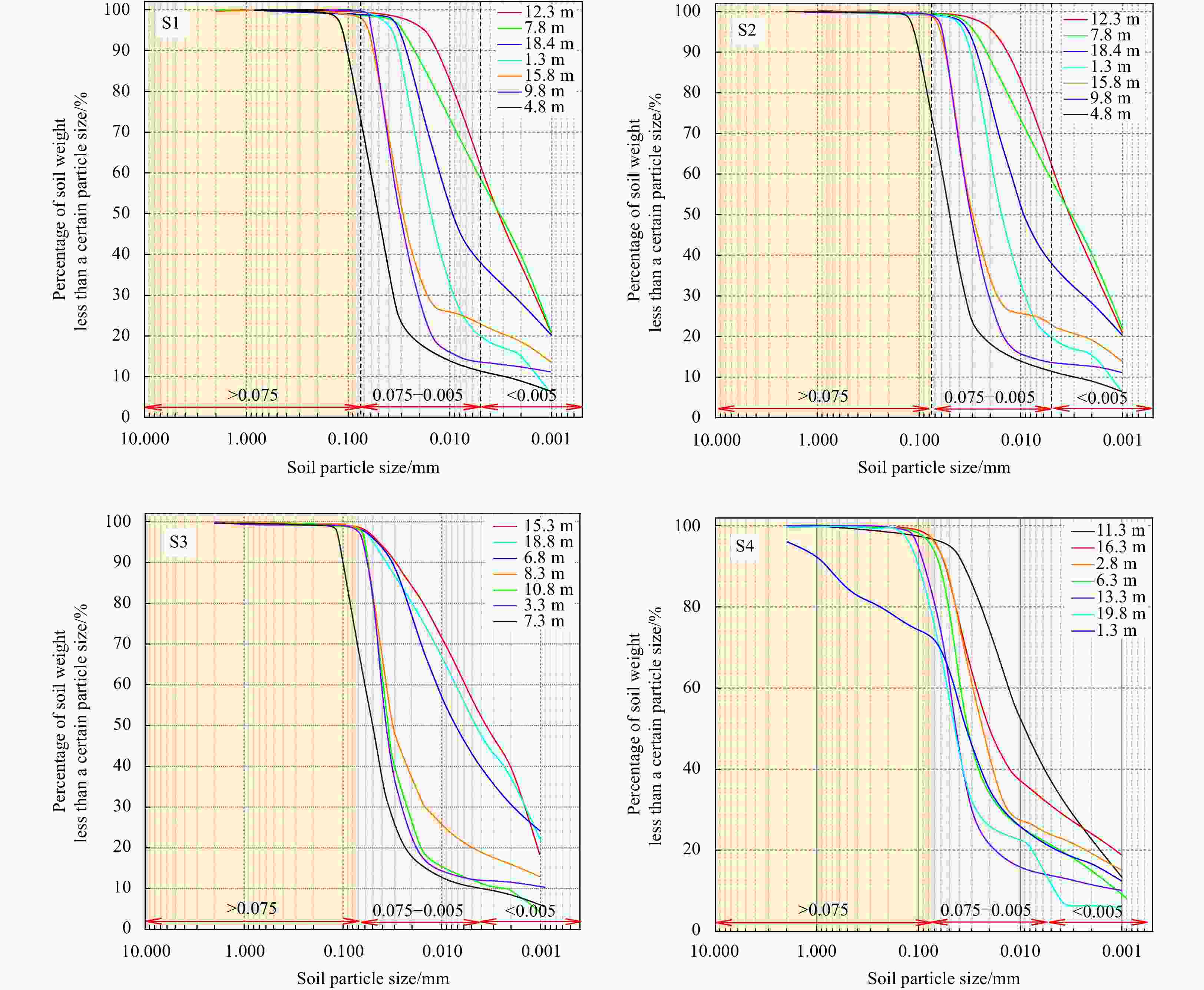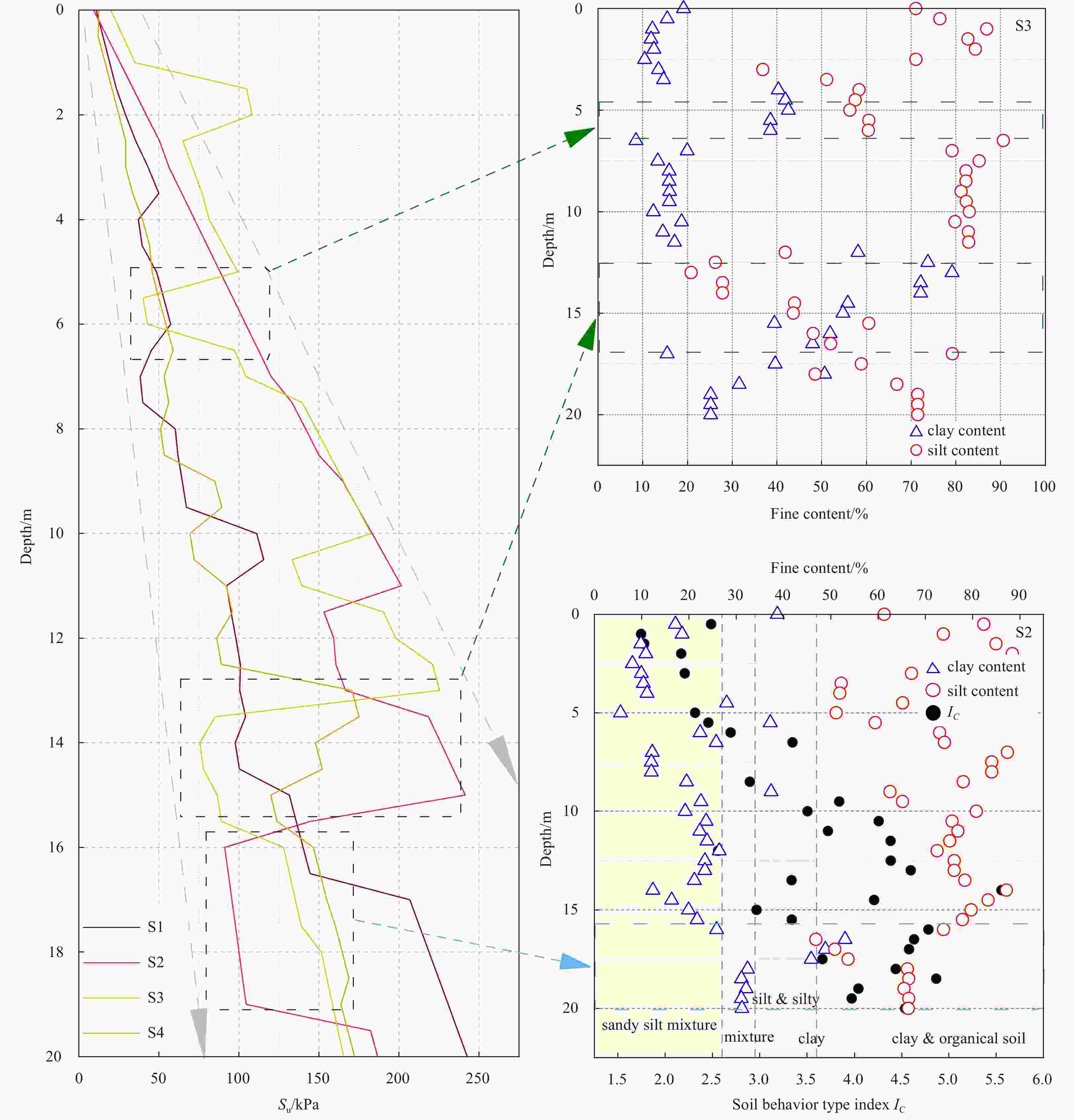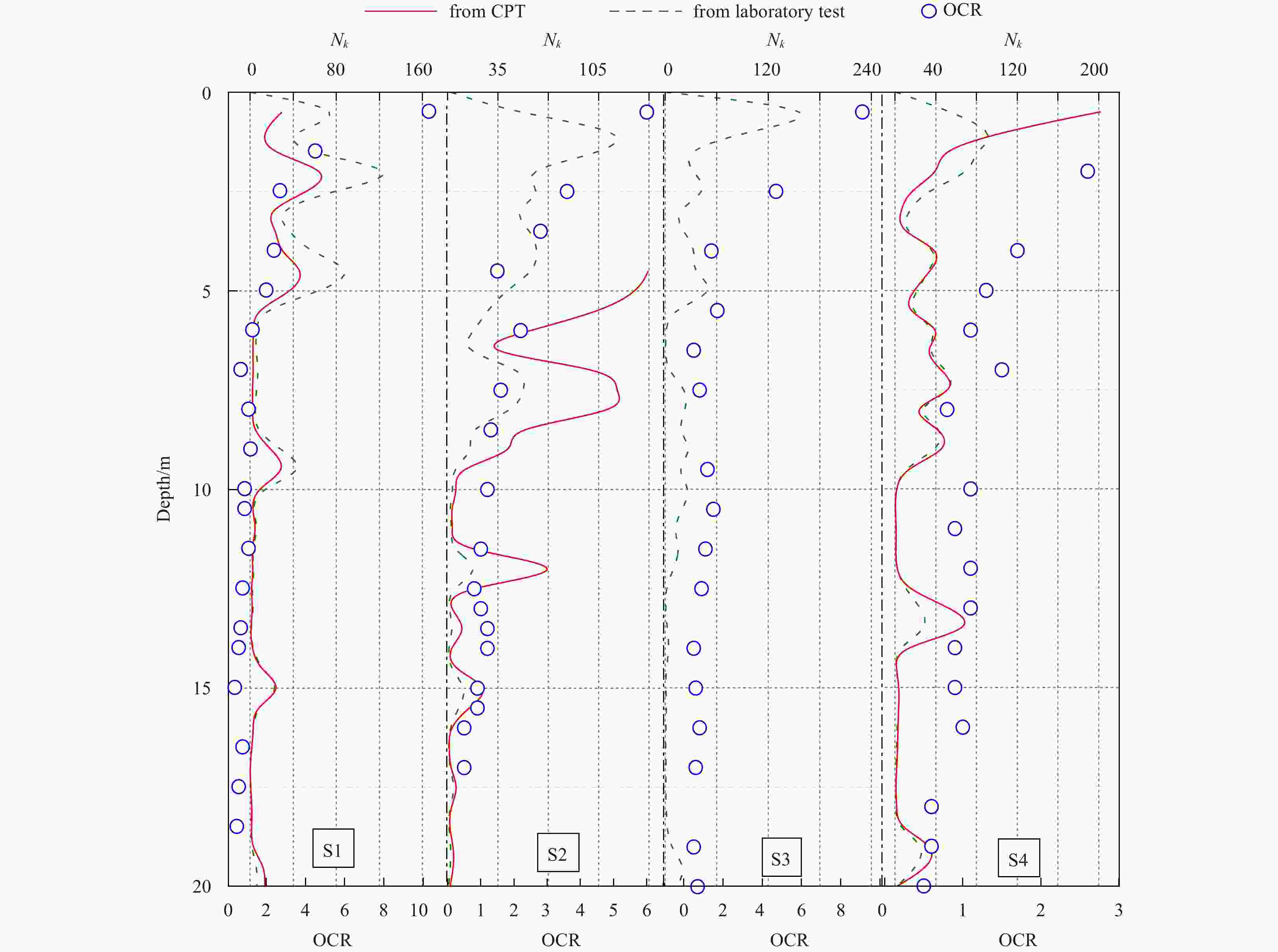CPT-Based estimation of undrained shear strength of fine-grained soils in the Huanghe River Delta
-
Abstract: The Huanghe River (Yellow River) Delta has a wide distribution of fine-grained soils. Fluvial alluviation, erosion, and wave loads affect the shoal area, resulting complex physical and mechanical properties to sensitive fine-grained soil located at the river-sea boundary. The cone penetration test (CPT) is a convenient and effective in situ testing method which can accurately identify various soil parameters. Studies on undrained shear strength only roughly determine the fine content (FC) without making the FC effect clear. We studied four stations formed in different the Huanghe River Delta periods. We conducted in situ CPT and corresponding laboratory tests, examined the fine content influence on undrained shear strength (Su), and determined the cone coefficient (Nk). The conclusions are as follows. (1) The fine content in the area exceeded 90%, and the silt content was high, accounting for more than 70% of all fine particle compositions. (2) The undrained shear strength gradually increased with depth with a maximum of approximately 250 kPa. When the silt content was lower than 60%–70%, the undrained shear strength decreased. (3) The silt and clay content influenced undrained shear strength, and the fitted fsh/qt function model was established, which could be applied to strata with a high fine content. The cone coefficients were between 20 and 25, and the overconsolidated soil layer had a greater cone coefficient.
-
Table 1. Cohesions and internal friction angles at shoal measuring points
S1 S2 S3 S4 Depth/m c/kPa $\varphi $/(°) Depth/m c/kPa $\varphi $/(°) Depth/m c/kPa $\varphi $/(°) Depth/m c/kPa $\varphi $/(°) 0.5–0.7 – – 0.5–0.7 – – 0.5–0.7 – 33.2 2.1–2.3 15.0 30.3 1.5–1.7 13.0 27.3 2.5–3.0 11.0 33.2 1.75–1.95 94.0 19.7 3.0–3.5 6.0 31.1 3.0–3.5 – 28.3 3.5–4.0 10.0 32.5 2.5–3.0 35.0 28.6 4.0-4.5 9.0 34.6 4.1–4.6 24.0 10.2 4.8–5.3 – – 4.0–4.5 12.0 35.3 5.0–5.5 8.0 26.2 5.2–5.7 11.0 19.7 5.9–6.4 10.0 33.5 5.5–6.0 8.0 13.3 6.0–6.5 1.0 38.3 6.2–6.7 14.0 12.3 7.6–8.1 14.0 32.9 6.8–7.0 6.0 29.8 7.0–7.5 17.0 14.4 7.2–7.7 20.0 6.6 8.7–9.2 1.0 35.7 7.5–8.0 14.0 34.2 8.0–8.5 19.0 10.2 8.2–8.7 40.0 6.8 10.1–10.6 1.0 27.7 9.5–10.0 – 42.4 9.0–9.5 11.0 35.1 9.2–9.7 22.0 11.9 11.5–12.0 18.0 25.8 10.5–11.0 3.0 26.7 10.3–10.5 19.0 13.5 10.4–10.6 32.0 20.0 12.5–13.0 4.0 26.8 11.5–12.0 20.0 31.2 11.3–11.5 12.0 23.1 11.4–11.6 35.0 13.3 13.1–13.3 8.0 32.0 12.0–12.5 133.0 19.5 12.3–12.5 22.0 14.7 12.4–12.6 – – 13.5–13.7 – – 13.3–13.5 11.0 12.3 13.0–13.5 120.0 30.8 13.4–13.6 12.0 16.4 15.0–15.2 25.0 17.7 14.3–14.5 18.0 9.2 14.3–14.5 55.0 31.6 14.1–14.6 30.0 11.9 15.5–15.7 – – 14.8–15.0 9.0 11.5 14.8–15.0 6.0 23.5 15.1–15.6 5.0 19.9 16.0–16.2 21.0 9.8 16.3–16.5 8.0 16.9 15.8–16.0 29.0 26.2 16.4–16.6 – – 16.8–17.0 – – 16.8–17.0 – – 17.8–18.0 28.0 27.3 17.4–17.6 9.0 26.0 19.0–19.2 13.0 19.5 18.8–19.0 27.0 16.0 19.3–19.8 3.0 29.5 18.4–18.6 – – 19.5–19.7 – – 19.3–19.5 – – 20.3–20.8 9.0 30.0 Note: – represents no data. Table 2. Average cone coefficient value (Nk) calculated at different measuring points
Station Maximum of Nk Average of Nk S1 80 22.04 S2 128 24.12 S3 210 20.25 S4 105 25.29 -
[1] Aas G, Lacasse S, Lunne T, et al. 1986. Use of in situ tests for foundation design on clay. In: Use of In Situ Tests in Geotechnical Engineering. Reston, VA, USA: American Society of Civil Engineers, 1–30 [2] Almeida M, Marques M, Baroni M. 2010. Geotechnical parameters of very soft clays from CPTu. In: Proceedings of the 2nd International Symposium on Cone Penetration Testing. Huntington Beach, USA [3] Anagnostopoulos A, Koukis G, Sabatakakis N, et al. 2003. Empirical correlations of soil parameters based on Cone Penetration Tests (CPT) for Greek soils. Geotechnical & Geological Engineering, 21(4): 377–387 [4] Chang Fangqiang, Jia Yonggang, Meng Xiangmei, et al. 2008. The degree of liquefaction of seabed induced by storm wave in Chengdao sea area. Marine Geology & Quaternary Geology, 28(2): 37–43 [5] Chen Xiaoying, Chen Shenliang, Liu Yongsheng. 2006. Sediment differentiation along nearshore zone of the Yellow River Delta. Acta Sedimentologica Sinica, 24(5): 714–721 [6] Du Yu, Guo Xiaoyong. 2019. Analysis of correlation between CPTU data and undrained shear strength of cohesive soil. Port & Waterway Engineering, (9): 289–293 [7] Han Meng, Li Guo, Ye Jichao, et al. 2020. Discussions of CPT derived undrained shear strength of cohesive soil in chengdao oilfield. Soil Engineering and Foundation, 34(4): 520–524 [8] Hong S J, Lee M, Kim J, et al. 2010. Evaluation of undrained shear strength of Busan clay using CPT. In: Proceedings the 2nd International Symposium on Cone Penetration Testing. Huntington Beach, USA [9] Jia Yonggang, Luan Haijing, Xu Guohui, et al. 2007. Changes in geotechnical properties of silt and its critical erosion threshold in Yellow River Estuary: influence of vibrating load. Rock and Soil Mechanics, 28(6): 1123–1128 [10] Jia Yonggang, Shan Hongxian, Yang Xiujuan, et al. 2011. Sediment Dynamics and Geologic Hazards in the Estuary of Yellow River, China (in Chinese). Beijing: Science Press [11] Librić L, Jurić-Kaćunić D, Kovačević M S. 2017. Application of cone penetration test (CPT) results for soil classification. Građevinar, 69: 11–20 [12] Liu Hongjun, Zhang Minsheng, Jia Yonggang, et al. 2006. Analysis of seabed stability under wave loading. Rock and Soil Mechanics, 27(6): 986–990 [13] Liu Xiaolei, Zhang Maosheng, Zhang Hong, et al. 2017. Physical and mechanical properties of loess discharged from the Yellow River into the Bohai Sea, China. Engineering Geology, 227: 4–11. doi: 10.1016/j.enggeo.2017.04.019 [14] Mcgann C R, Bradley B A, Taylor M L, et al. 2015. Development of an empirical correlation for predicting shear wave velocity of Christchurch soils from cone penetration test data. Soil Dynamics & Earthquake Engineering, 75: 66–75 [15] Meigh A C. 1987. Cone Penetration Testing: Methods and Interpretation. Kent, England: Butterworths and Company Publishers, Limited [16] Prior D B, Yang Z S, Bornhold B D, et al. 1986. Active slope failure, sediment collapse, and silt flows on the modern subaqueous Huanghe delta. Geo-Marine Letters, 6(2): 85–95. doi: 10.1007/BF02281644 [17] Rémai Z. 2013. Correlation of undrained shear strength and CPT resistance. Periodica Polytechnica Civil Engineering, 57(1): 39–44. doi: 10.3311/PPci.2140 [18] Ricceri G, Simonini P, Cola S. 2002. Applicability of piezocone and dilatometer to characterize the soils of the Venice Lagoon. Geotechnical & Geological Engineering, 20(2): 89–121 [19] Robertson P K. 2004. Evaluating soil liquefaction and post-earthquake deformations using the CPT. In: Geotechnical and Geophysical Site Characterization. Vol 1. Edmonton, Canada: University of Alberta, 233–249 [20] Robertson P K. 2009. Interpretation of cone penetration tests—a unified approach. Canadian Geotechnical Journal, 46(11): 1337–1355. doi: 10.1139/T09-065 [21] Robertson P K, Fear C E. 1997. Liquefaction of sands and its evaluation. In: Proceedings of International Conference on Earthquake Geotechnical Engineering. Rotterdam: A A Balkema, 1253–1289 [22] Robertson P K, Wride C E. 1998. Evaluating cyclic liquefaction potential using the cone penetration test. Canadian Geotechnical Journal, 35(3): 442–459. doi: 10.1139/t98-017 [23] Shi Changxing, You Lianyuan, Li Bingyuan, et al. 2003. Natural consolidation of deposits and its consequences at the Yellow River Delta. Scientia Geographica Sinica, 23(2): 175–181 [24] Wang Zhaoyin, Wang Wenlong, Tian Shimin. 2007. Mineral composition and distribution of the sediment in the Yellow River basin. Journal of Sediment Research, (5): 1–8 [25] Wang Qing, Xiao Shufang. 2000. A review on the engineering geology of marine soft soil. World Geology, 19(3): 253–257 [26] Xue Chunting. 1994. Division and recorgnition of modern Yellow River Delta Lobes. Geographical Research, 13(2): 59–66 [27] Yang Xiujuan, Jia Yonggang. 2013. Long-term field observation of sediment consolidation process in Yellow River Delta, China. Chinese Journal of Geotechnical Engineering, 47(6): 671–678 [28] Yang Zhongnian, Shan Hongxian, Jia Yonggang, et al. 2011. Erosion-deposition evolution characteristics of north beach in Yellow River Delta. Chinese Journal of Geotechnical Engineering, 33(S1): 159–169 [29] Yu H S, Herrmann L R, Boulanger R W. 2000. Analysis of Steady Cone Penetration in Clay. Journal of Geotechnical & Geoenvironmental Engineering, 126(7): 594–605 [30] Zhang Hong, Liu Xiaolei, Jia Yonggang, et al. 2020. Rapid consolidation characteristics of Yellow River-derived sediment: Geotechnical characterization and its implications for the deltaic geomorphic evolution. Engineering Geology, 270: 105578. doi: 10.1016/j.enggeo.2020.105578 [31] Zhang Jianmin, Shan Hongxian, Jia Yonggang, et al. 2007. An experimental study of nonuniform consolidation of rapid sediment seabed soils at Yellow River mouth subjected to wave and tide wave loading. Rock and Soil Mechanics, 28(7): 1369–1375,1380 [32] Zhao Yuling, Feng Xiuli, Song Sheng, et al. 2016. Geochemical partition of surface sediments in the seas near the modern Yellow River Delta. Marine Sciences, 40(9): 98–106 [33] Zhou Yongqing. 1998. Erosion process and main features of underwater coast slope of the northern coast in the Yellow River Delta. Marine Geology & Quaternary Geology, 18(3): 79–85 [34] Zhou Qijian, Jia Yonggang, Ma Decui, et al. 2006. Research of consolidating inhomogeneity of silt seabed in Yellow River estuary shore. Rock and Soil Mechanics, 27(7): 1147–1152 -





 下载:
下载:











